Saturday, 25 June 2011
Distance 38 km
Duration 8 hours 25 minutes
Ascent 772 m, descent 998 m
Map 149 of the TOP100 lime-green series
Topoguide (ref. P691) Les Monts du Beaujolais et du Lyonnais… à pied
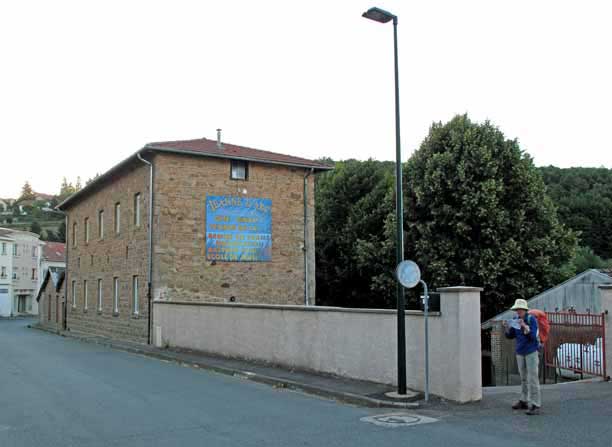
We rose with our usual promptness at 6:15 and exchanged a few words with the working man, our fellow inhabitant, who evidently treated the gîte as his private domain normally, although he was polite enough.
He hurried off and we ate our muesli in the comfort of the kitchen, looking out the window at a limitless scene of fields and forests dropping away from the town.
Keith was coughing in an ominous way and I was still a wreck from the ‘flu, but once we set off we felt better. It was a lovely morning.
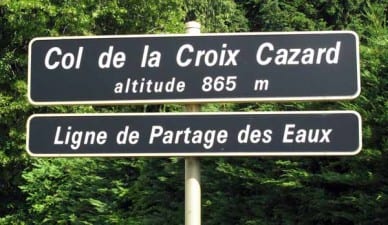
To rejoin the GR we continued up the main street that we had arrived on, which became the D1 and took us up to the col. Here there was the usual cross, a relic of the days when the roads had been bullock tracks and reaching the col was an occasion for thanksgiving (as it still is today for those of us on foot).
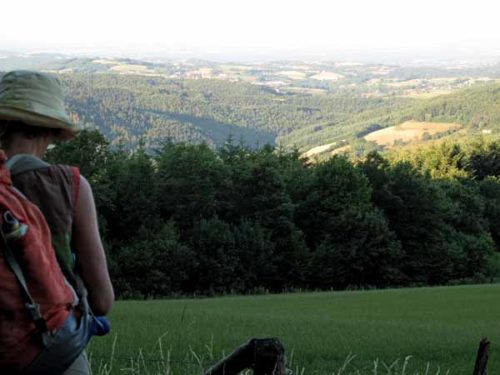
There were also huge billboards describing the charms of the Tour Matagrin, a nineteenth-century tower marking the high point of the mountains of the Lyonnais.
For the first kilometre, the GR followed the tar road along the ridge and then diverged onto a forest path, but we were not paying attention and thought that the diverging signs referred to the detour to the Tour Matagrin, which we had decided not to do in our weakened condition.
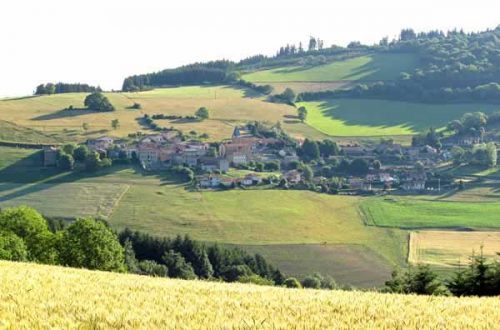
The result was that we stayed on the road for another couple of kilometres, but it was no bad thing at that early hour and we were able to reconnect with the GR after a slight shuffle.
We descended through fields of ripe wheat, some already harvested, with the village of Affoux below us on the left.

Before long we plunged into the forest again, crossed a stream and continued on a beautiful shady path.
Just ahead of us was a young chap on a bike taking his dog for a walk, but he soon left us behind.
When we came out into the open we were high above the houses of Villechenève, where we hoped to find a bar, and having descended into the streets weu found that there was indeed one, and a little supermarket too.
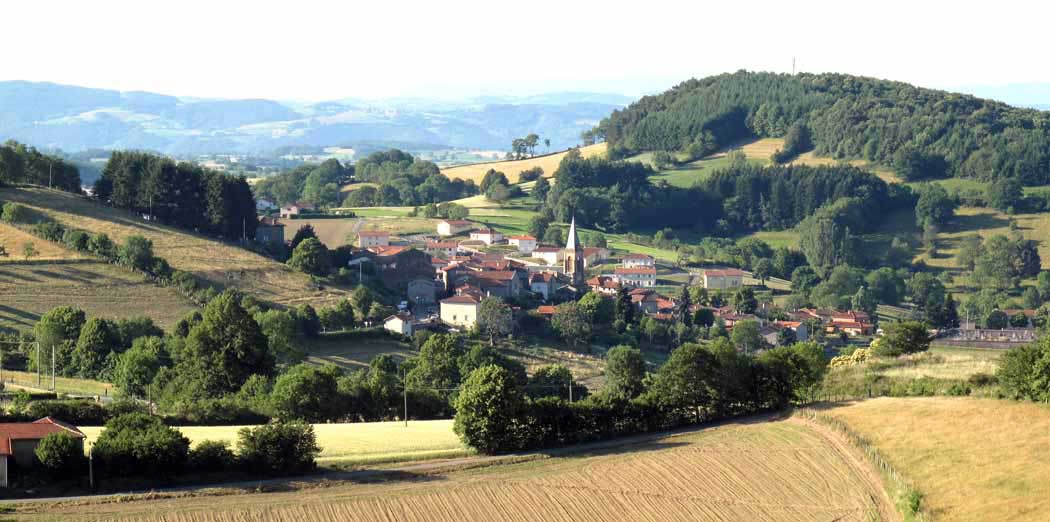
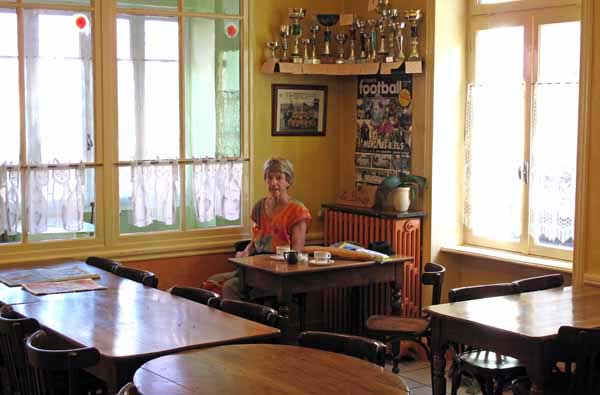
We were too late for croissants, although it was only 8:30, but coffee was our main requirement and we ate some fresh bread with it in the rather austere, empty brown bar (as we left the village we discovered another bar that looked a good deal more appealing).
Once out of Villechenève we wandered along as far as les Olmes, where the road ended, but the track continued down through a landscape of golden wheat, across a stream and up suddenly, past a farmhouse defended by a hysterical dog, to another road. The GR was a mixture of paths and roads but the signs were good and we did not get lost.
Below us we could see the village of Longessaigne in its green bowl. Near the farm of Molagy, where the track deviated around an ancient lime tree, we actually met another walker, a woman, wading along with two walking poles but no pack.

Perhaps she was practising for some future expedition – she passed by with the briefest of nods so we did not find out.
Emerging from a wooded section, we found ourselves at les Auberges, which, to our surprise, lived up to its name. The indoor tables of the restaurant were set for lunch but there was a vine-shaded terrace at the side, occupied by a boisterous crowd of motor-bike riders and one old woman reading a novel.
Another round of coffee and a carafe of water made an excellent second rest stop. It is always pleasant to eavesdrop on other people’s chatter, if only to improve one’s French. From here we left the GR7 and took a road going south, which connected after a kilometre or so with the GRP (Tour des Monts du Lyonnais).
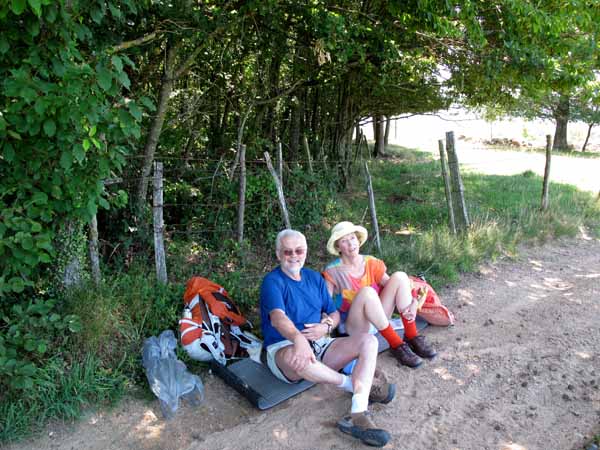
This was a delightfully rural track until we got to les Maisons Neuves, where suddenly and inexplicably the little intersection was lined with long metal factory buildings, for what purpose we did not discover. But it was only a brief interruption of our peaceful way, and not long afterwards we stopped under a hedge beside the track for lunch.
This was the point where we had to decide whether to keep going along the GRP to Sainte-Foy-l’Argentière, or to head straight for St-Symphorien-sur-Coise.
Despite the helpfulness of our hostess last night, we were not sure that the hotel at Ste-Foy-l’Argentière was still operating, and as we had no phone card, we could not telephone to find out.
The thought of finding it closed and having to continue up the terribly steep escarpment to Aveize to find a bed was too depressing, so we decided to push on directly to St-Symphorien, which was further away but not as steep. Or so we thought.
It was downhill all the way to Souzy. Most of the time we were on a tiny road and although it was hot, we felt capable of walking the rest of the distance. The village was sunk in Saturday afternoon torpor, except for a pétanque competition on the only flat piece of land in the place. The road hooked around the base of the church and then dived down to the wide valley floor.
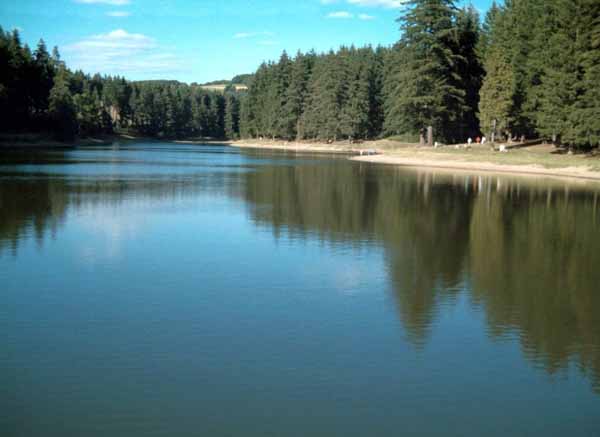
This was the valley of the Brevenne, a large river flowing east towards the Rhône, although it rises only half a dozen kilometres from the Loire. It makes a distinct break in the chain of mountains that we were following, and divides the Beaujolais from the Lyonnais.
Having lost an enormous amount of height in getting down to the Brevenne, we then had to regain it. The valley itself was a bit of an industrial wasteland of factories, car yards and warehouses, but once we had crossed the highway (the N89) and the river, we left it all behind and started to rise.
By then we were back on the GRP, which was fortunate as the hillside was dotted with houses and there were little roads going everywhere, making it hard to navigate. As we got higher, so did the gradient.
The GRP took a short cut up a muddy, nettle-infested lane as steep as a laundry chute, and then we walked along the D61 for a while, ignoring the GRP which plunged down a defile and back up to the road for no discernible reason. Soon we came to another GRP short cut, just as choked with nettles and even steeper, and one glance at this convinced us to stay on the road. Whether this was a good idea we are not sure, but it was certainly very unpleasant.
The distance was much further and the afternoon sun bore down like a blow torch (we later found that it was 36 degrees). The beauty of the surrounding forest and the expansive view over the valley were lost on us as we slogged up the relentlessly rising bitumen.
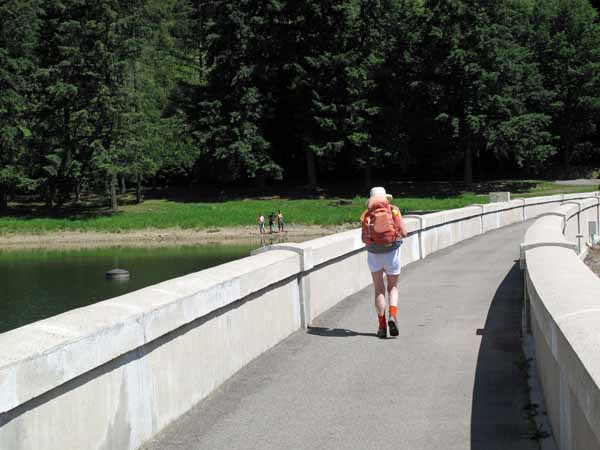
Just before les Brosses we turned uphill on a dirt track that was almost too severe to negotiate, at least for me.
I was failing fast with my usual lack of stamina. Several rest stops were required to get me up to the ridge, where we crossed the D34 and immediately plunged down to the artificial lake of Gimond.
There were people having picnics and strolling at their ease along the banks. I looked at them with hatred as we stumbled over the dam wall and reconnected with the GRP at last.
From there the path was wide and gentle, leading up through the forest to the summit of the climb. Nevertheless we made heavy work of it.
There were various other people on the track, including a short, gnarled man and a younger woman, who passed us and then stopped to talk.
He was a native of St-Symphorien-sur-Coise and a good walker, in charge of maintaining the local section of the GRP. A few years ago he had done the pilgrimage to Compostela, so he was naturally interested in what we were doing. The woman was his daughter, visiting for a week’s holiday. We asked him about the camping ground at St-Symphorien-sur-Coise that was mentioned in the Topoguide, and found out that there was no such thing, but that there was a walkers’ gîte close to the church. So the two errors in the Topoguide cancelled each other out.
We parted company with them at the top, as we were going into the village of Pomeys for a drink. Just before the village we passed a spring, whose waters had refreshed that great fourth-century traveller, St Martin of Tours, on his way past. The happy result was that the spring never again dried up, or so the story goes.
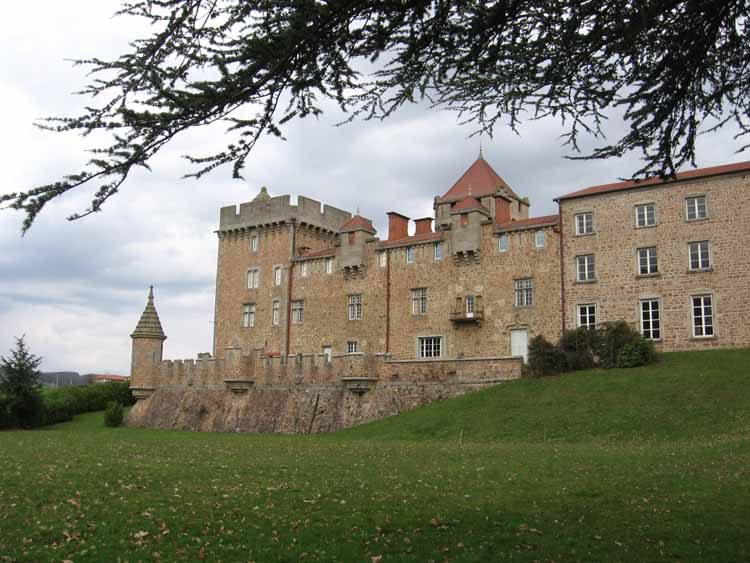
We, on the other hand, were thoroughly dried up as as we staggered into Pomeys. As is often the case on summer weekends, there was a fête de la musique taking place in the village.
The square outside the bar was crowded with spectators as a woman in a silver fishtail dress performed a belly dance to oriental piped music.
Apart from the upsetting pallor of her midriff, she seemed to be quite good – sultry and graceful – but we were too exhausted to leave our table inside the bar to have a closer look. Then some schoolgirls came on and did a scarf dance, wagging their hips with child-like innocence.
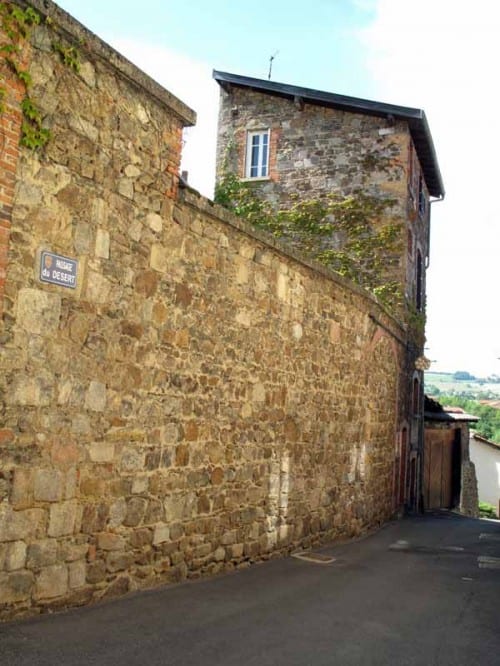
Having disposed of a large carafe of water, we then had coffee, or Keith did, but I had tea, as our two previous coffees had tasted bad to me. Either I was having a relapse of the ‘flu or the department of the Loire was not such a coffee paradise as the Rhône, where it is always good and always served with cream.
The final three kilometres to St-Symphorien-sur-Coise was a descent through fields, except for one slight climb near the imposing walled château of Pluvy, but even the downhill walking was a trial to me.
As we entered the streets of the town and crossed the bridge, we saw the massive church looming high above us on a crag. Wedding guests the size of ants scurried about the door.
We then trudged up into the town on a large, curving road, and found ourselves in the centre, which looked good, with several bars.
At the little Casino supermarket we asked about the gîte and were directed to the pâtisserie next door. The pâtissier, Paul Berger, who was also the guardian of the gîte, took our €8.50 each and gave us directions, together with a large key, and we set off.
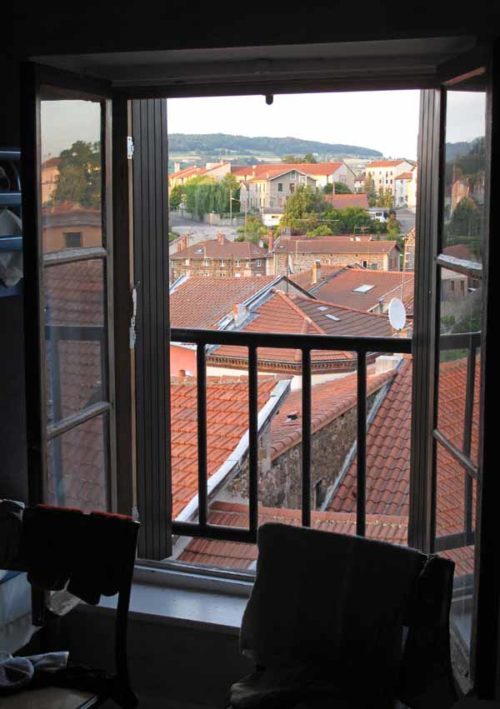
Up a side lane from the market square, we came to the church, which had looked so discouragingly high as we approached. We were amazed that we had climbed so far. The gîte was nearby, although we did not see it until a woman pointed it out to us. It was a narrow four-storied house with dormitories on the top two floors, a kitchen below that and the bathroom at the very bottom.
There were signs of another occupant on the third level, so we went up to the topmost room, flung ourselves down on bunks and remained stationary for an hour, unable to move. It was blissful and so was the shower that followed. From somewhere nearby, the sound of singing floated in the window, as so often before on this walk.
Then the doorbell rang – it was another pilgrim arriving, a lone Frenchman. He was walking on some variation of the pilgimage, having come from Yseron that day. His aim was to go to St-Galmier, then over the Loire to St-Georges-Haute-Ville and on as far as le Puy. Next year he would do another stage of his pilgrimage. He was small, elderly and weak-looking, as is often the case with the pilgrims that we meet. We felt like giants with our long legs and beefy bodies.

At 7 pm we emerged in our evening clothes (i.e. the shirts that we had not walked in that day, and sandals instead of boots) and strolled about.
After such a hot day, there were plenty of people in the main square enjoying the relative coolness. Many of them were sitting outside the bar, fancifully named the Aloha Café.
We went down to the Place de la République to look at the hotel, which would have been our only choice if we had not had the good luck to meet the man who told us about the gîte. It looked derelict, but it may have been still operating – we did not care.
Back in the Place du Marché, we settled down at the bar for our usual rosé and pastis.
It was the sort of self-contained, self-sustaining town where the same families had lived for generations and everybody knew everything about everybody else. Or so our waiter told us – he was one of them, and very happy with his lot.
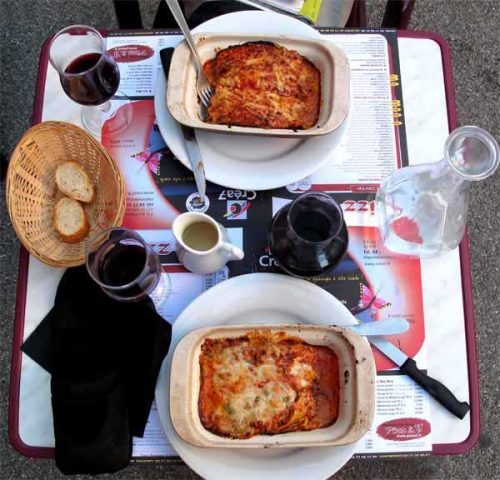
The possibilities for dinner were a pizzeria or a kebab shop in the square, or a restaurant down at the old station (relic of a tramway that had been here in former times). The latter looked good but the menu was pork, the same as we had had last night, so we went back to the pizzeria.
The typical French pizzeria does not limit itself to pizzas – they serve pasta, steaks, salad, indeed all the usual dishes. We sat outside and had a green salad followed by lasagne, and a carafe of wine.
The couple at the next table engaged us in conversation, during which the woman said that Australia was almost a land of fantasy to most French people, not like a real place at all. We felt like spirits from another universe, albeit spirits with hearty appetites and faltering French.
It was an easy stroll back to the gîte and we had a delicious sleep, the only drawback of which was that getting up to go to the toilet meant descending four flights of stairs, and Keith hit his head on a low beam every time he entered the bathroom.
Previous day: Les Sauvages to Violay